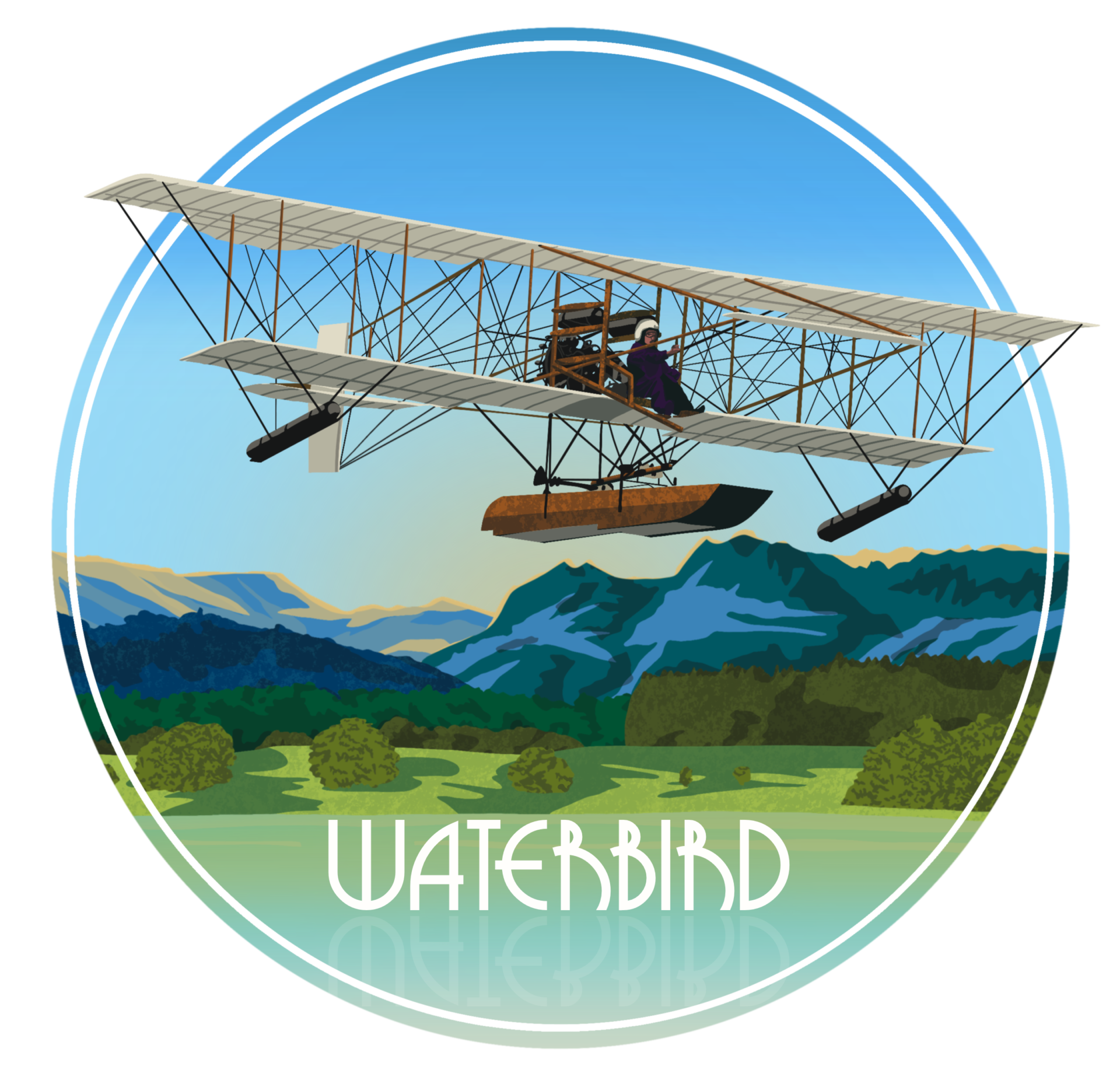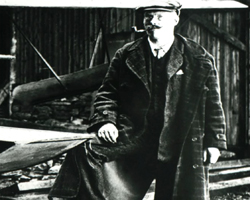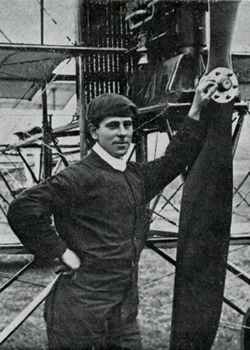BROOKLANDS AERODROME
‘Alliott Verdon Roe attended one of the first meetings at the new Motor Race Track, Brooklands on 22 July 1907. In the course of this visit he looked closely at the farmland area in the middle of the Motor Course and remarked to his brother Humphrey that it might be an ideal place for test-flying aircraft because, early in the mornings, it was reported to enjoy absolutely still air.’ – Sir Peter Masefield.
BACKGROUND
‘There will be a straight run measuring more than three-quarters of a mile in length and from 250 yards to 400 yards in width, with space at each end for turning.’ – The Motor magazine, 26 January 1909:-
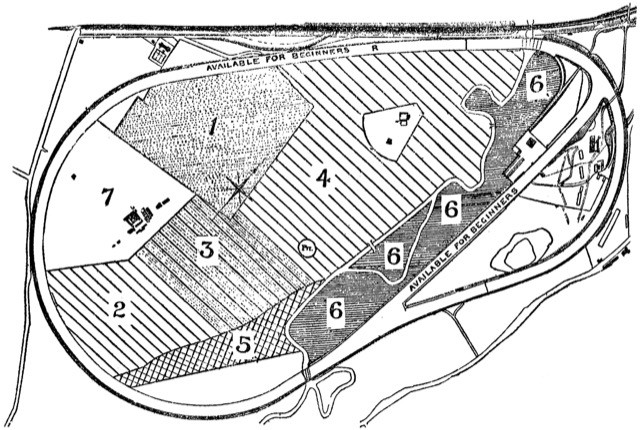
1. Cultivated – quite flat
2. and 4. Even ground – passable to motor cars
3. Grass plot at least 250 yards square as level as a tennis court
5. Can be made available if required
6. Meadows – suitable for alighting
7. Too rough to be levelled without considerable expense.
‘1909 to 1911 were wonderful, amazing, arousing years the like of which we will never see in the air again. Years of extravagant prophesy and wild, unbalanced enthusiasm.’ – J Laurence Pritchard, Eighty Years of British Aviation, the Work of the Royal Aeronautical Society from 12 January 1866 to 12 January 1946. National Aerospace Library.
‘A few years ago crowds used to assemble to see a motor car, and the generation that introduced the automobile is now assembled in honour of the aeroplane. Brooklands itself was built for the car, yet is is the aeroplane that attracts most people to its grounds.’ – Flight magazine, 29 July 1911.
THE SPIRIT OF BROOKLANDS
In a booklet The Brooklands Story A. V. Roe & Company 1910/1911, Howard Pixton wrote ‘I found Brooklands comprised about two dozen wooden hangars [the Avro School occupied Nos. 6 and 15], with earth floors and wood and canvas shutters instead of doors – all very primitive. At one end of the ground was the only too-well-known sewage farm, into which all the best aviators made a habit of landing. … We were a mixed crowd, some had more money than they could ever spend, some were as poor as I was, some had their own machines, others were merely mechanics hoping to get a chance on their employer’s aeroplanes. It made no difference. In flying there were no class distinctions, we were all friends, all ready to help one another, all bound together by the same enthusiasm. Never since those days have I encountered such a wonderful spirit.’
‘The original sheds had no windows, so we had to take the shutters down for light, and during the cold winter we had an old bucket with a coke fire to warm the handles of the tools. It was an awful time: mud floor, leaky roof (we used the sheds before the roofs were finished), cold, long hours and floods. However, the coke fire cheered us a lot because the smoke made us think it was warm.
‘Aviation became a trade. Those who had worked for the love of of the science, asking only the poorest food and lodging, were either dead or bankrupt, and so finished days which can never be repeated in the growth of a science. This example of a group of men sacrificing everything for the work has been seen in steam, electricity, motor-cars, etc., but never in quite the form shown in aviation, because the earlier engineering sciences did not necessitate living in communities, as did aviation. It is improbable that anything of the sort will arise again, because money has apparently become definitely the key to all progress. The next openings in science will probably be too elaborate for the needy worker.’
– Reminiscences of the Early Days of Aviation at Brooklands by R L Howard-Flanders, Paper before the Institution of Engineers, 1924.
Converted from No. 8 hangar, formerly occupied by Louis Paulhan then Martin & Handasyde, the location was close to the Byfleet Banking on the motor racing circuit. It was opened by Eardley Billing (brother of Noel Pemberton-Billing who founded Pemberton-Billing Ltd at Southampton, later renamed ‘Supermarine’), manager of the Lane Gliding School at No. 1 hangar, and his wife Ada.
‘Mrs Billing rather mothered everyone, bandaging cuts, sewing on buttons, and even darning socks for some.’ – Pixton. Her famous teas were served outside during the summer.
Pixton decreed it to be the highlight of the place: ‘We all assembled to drink tea, discuss flying, talk about the latest crash and new ideas, and gradually fewer primus stoves and old buckets holding coke fires were found in the hangars’.
‘The atmosphere combined the stinging smell of castor oil, which then lubricated the aero-engines, with those of the kitchen, to form an odour for ever nostalgic to those who experienced it’. – Fifty Years of Brooklands by Charles Gardner.
‘On hot days in the summer the Blue Bird was infested with wasps, and “intrepid airmen”, to use a very irritating cliché of the popular press, would arm themselves with petrol syringes. Jam attracted the wasps, and the jam dishes were accordingly the target for streams of petrol. The dead or sleeping wasps were picked out, and after a few minutes the jam seemed to taste little the worse to hungry men!’ – The Old Flying Days by Major C C Turner.
Gertrude Bacon would spend Saturday or Sunday afternoons at Brooklands. Note the world’s first flight ticket office built in 1911 at far right of this photo – source: Brooklands Museum Trust. In her book Memories of Land and Sky, she described life at the café: ‘Tea was served in an unpretentious fashion; and tea-time was the social function and climax of the afternoon. … All fresh from the thrill of their early flights, with wind-blown locks and oil-splashed garments, those keen-eyed, laughing boys would troop in, put pennies in the jingling music box, run the little tables together to make one long board, and sit down to many cups of tea and the liveliest, wittiest chatter and banter in which the effervescent spirits of the flying temperament could find vent. It was the sort of scene that Rudyard Kipling delights in and only he can depict. Alan Boyle would be there, Graham Gilmour, Radley, Pixton, Pizey, George Barnes, the Barnwell Brothers, the brothers Petre, Fleming, Fisher, Astley, Captain Maitland, C C Turner, Howard-Flanders, Sayers, Herbert Spencer, A V Roe and so many others. Some made history, some simply faded out, some crashed.’
The War Office commandeered the aerodrome and the café became the officers’ mess for the Royal Flying Corps. On 11 August 1914, Flight Sub-Lieutenant Harold Rosher wrote to his father from the café. ‘The Bristol & Colonial Aeroplane Company’s [‘Bristol’] instructor, Mr Stutt, sits immediately behind you, controls the engine switch and covers your hand on the stick. He took me straight up two or three hundred feet and then volplaned down. He always does this with new pupils to see how they take it.’ – The Royal Navy’s Air Service in the Great War by D Hobbs.
The café was destroyed by a fire on 28 March 1917. ‘When one remembers how one smoked, and ran brazing lamps, and even engines and used plain oil lamps in the sheds, regardless of open cans of petrol and even pans full of petrol for the washing of parts, it seems a miracle that the whole place was not burned out many years ago.’ – Pixton.
THE BIG BAT
On 24 September 1910, Gertrude Bacon was taken up on cross-country flights from Brooklands by Graham Gilmour in his Blériot XI monoplane known as The Big Bat – Flight magazine, 1 October 1910. Both ‘THE BAT‘ – Royal Aero Club Trust, and ‘BIG BAT‘ – Flight magazine, 3 January 1930, were painted on the rudder. Initially it had a 35hp JAP engine – British Aircraft Before the Great War by Michael Goodall and Albert Tagg, but when Gertrude Bacon flew as a passenger she reported there was a [50hp] Gnome – Memories of Land and Sky.
ORIGIN OF THE VERB TO “TAXI”
Gilmour led a party of Brooklands men dressed in mechanics’ overalls into the Coventry Restaurant in Leicester Square, London, and caused a bit of a flutter among the smart patrons. … Gilmour brought a new word into Brooklands, a word derived from London’s new motor vehicle, the taxi-meter-motor cabriolets. Instead of rolling out a machine, we now taxied along the ground.’ – Howard Pixton: Test Pilot & Pioneer Aviator by Stella Pixton. This is corroborated in Pure Luck: the Authorised Biography of Sir Thomas Sopwith, by Alan Bramson: ‘D. G. Gilmour, a famous pioneer pilot of the day, abbreviated ‘Taximeter-motor-cabriolet’ and applied it to aircraft manoeuvring on the ground’.
‘It is interesting here to note that the much reprobated verb to “taxi” has official sanction. It is a good little word, in that it is unlike any other and expresses a distinct idea, namely, that of running an aeroplane along the ground under its own power.’ – The Aeroplane magazine, 7 November 1912.
LOW FLYING
On 25 May 1911, the first Aerial Navigation Bill was presented to Parliament by Winston Churchill, then Foreign Secretary, the purpose of which included the prevention of flying close to large public assemblies. At the invitation of the Parliamentary Aerial Defence Committee, officers of the Royal Aero Club (‘RAeC’) attended a meeting at the House of Commons, when amendments proposed by the RAeC were accepted by Churchill. It was recalled that Gilmour and others had attracted unwelcome publicity on 1 April by flying low over the Oxford and Cambridge boat race. With the Coronation procession in a few weeks, the Bill was passed through both Houses and received the Royal Assent in record time on 2 June.
In 1912, a Public Inquiry was held as to whether the Act should be applied so as to prohibit flying over Windermere – please see at this link under PROTESTS.
On 18 July 1911, Gilmour had his Aviator’s Certificate suspended for 1 month by the RAeC Committee for flying in a manner dangerous to the public. That is, for flying low over Henley Regatta in a Boxkite on 7 July. He was flying for Bristol, which applied to the High Court for an injunction against the RAeC, but on 20 July it was refused. So, they went to the Court of Appeal on 21 July and succeeded, on the basis that the RAeC had no power to suspend his Certificate No. 75 issued by the Aéro-Club de France. The photograph of Gilmour in The History of British Aviation 1908-1914 by R D Brett carries the caption ‘The stormy petrel: whose dashing flying gave rise to much litigation’. Bristol unsuccessfully opposed Edward Wakefield’s application for a patent for the stepped float on 8 March 1913.
Gilmour was tragically killed when his aeroplane crashed on 17 February 1912.
CLIFFORD FLEMING-WILLIAMS
Fleming-Williams was a pioneer of making drawings from the air so as to prove the use of aeroplanes for military observation purposes. On 1 April 1911, he made a drawing of Brooklands.
A. V. Roe & Company (‘Avro’) was commissioned by Edward Wakefield to build an Avro Curtiss-type aeroplane, which, when later converted to a hydro-aeroplane at Windermere, became known as Waterbird.
Test-flying was carried out at Brooklands [the Agreement between Avro and Wakefield had given Avro the alternative option of Trafford Park, Manchester] by Francis Conway Jenkins, Louis Noël, Ronald Kemp and Frederick Raynham. 3 circuits of the airfield were flown.
The span of the upper wings was extended by adding another bay, the control wheel was exchanged with a column (patented by Alliott Verdon Roe), and both the horizontal tail and the rudder were replaced.
There is no photo known of the testing. This painting by Stephen Chard GAvA depicts the scene:
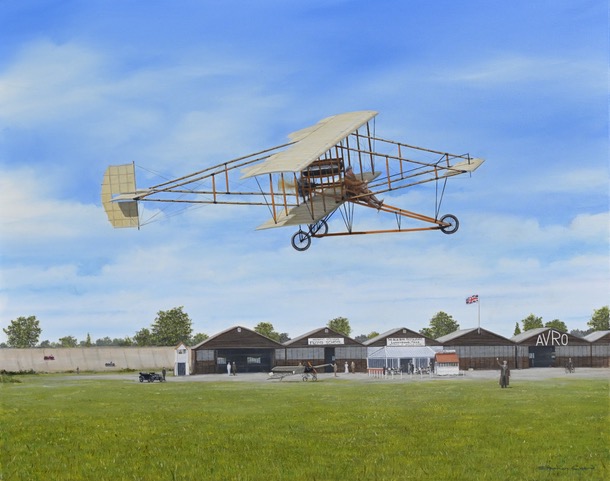
In a letter to his wife of 1 July 1911, Wakefield wrote ‘At about 8 p.m. under young [he was 17] Mr. Raynham’s skilful piloting a splendid flight took Brooklands by storm. Rising slowly and turning at first in wide sweeps she soon gathered speed and height and sailed for some miles (4 at least) over houses and trees, and then landed in front of her hangar as gently as a thistledown. Thus she passed her contract test with flying colours.’
Testing and delivery of the Avro Curtiss-type: extracts from Flight magazine, 1911:-
On Thursday [25 May] a new machine arrived from Messrs. A. V. Roe and Co.’s Manchester works, constructed to the order of Mr. Wakefield. It is of the Curtiss type, and designed to start from water as well as on land, and is fitted with a 50-h.p. Gnome. The first trials, which will not be made with the floats, only with the wheels, should take place in about ten days. The first tests on water are to be made in the north of England. – 27 May
Louis Noël made some short flights on the Avro-Curtiss. Some interest was caused on Tuesday [27 June] when the Avro-Curtiss, which has been built by Messrs. A. V. Roe and Co., was brought out. Mr. Ronald Kemp at his first attempt flew very well and came back in perfect style. Louis Noël made one or two rough landings, the onlookers being surprised to see the rigid wheel-base stand it so well. This machine, as well as an ordinary Avro biplane, is to be fitted with a float and tried in the North. – 1 July
The chief item of news is that the Avro biplane of the Curtiss type has been doing very well in the hands of Mr. Raynham, several circuits of the ground being made at a height of 60 to 100 feet. It will shortly be fitted with hydroplanes for experimenting over water. – 8 July
Mr. A. V. Roe has delivered the Avro [D] biplane ordered by Commander Schwann, at Barrow-in-Furness. The Roe-Curtiss biplane has gone to Mr. Wakefield, at Windermere. – 15 July
The Brooklands track had been opened on 17 June 1907 by Lord Lonsdale, who accepted Wakefield’s request that he become Patron of The Lakes Flying Company by letter of 25 December 1911.
HERBERT STANLEY ADAMS
Herbert Stanley Adams was a pupil at the Avro Flying School, Brooklands, where he secured Aviator’s Certificate No. 97 on 27 June 1911. He had become interested in aviation through motor racing there. Wakefield wrote on 5 July ‘I am arranging for Mr Adams, an amateur gentlemen pilot, to come and help me at Windermere. He is young and shy, but presentable, and has been most obliging and helpful to me’.
Adams revisited Brooklands and, on behalf of The Lakes Flying Company, paid £180 for the airframe of an Avro-built biplane previously owned by John Duigan. – A Flying Life: John Duigan by David Crotty. Having arrived at Windermere on 13 June 1912, where rebuilding took place including installation of the ex-Waterbird engine, the initial name was Seabird.
AVIATION MAP – The RAeC Year Book 1912
– ‘In my opinion, these early days were the most important in all aviation history. Everything was new and untried, even the air was an unknown element’. – Howard Pixton, in 1954.
